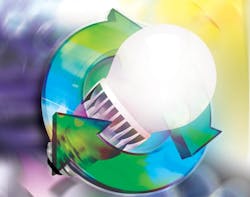SSL manufacturers push DOE regulatory policy change on LED lamps
The US Department of Energy is moving to change the definitions of general service lamps as urged by SSL manufacturers and NEMA, and in doing so is enabling the manufacturers to continue making some specialty lamps based on legacy sources while erasing projected energy savings expected through a transition to LEDs.
The US Department of Energy (DOE) has begun the process of changing the scope of which products fall under the designations “general service lamp” (GSL) and “general service incandescent lamp” (GSIL) — essentially rolling back policy that would have required a conversion of more lamp types to LED sources in the coming year. The NEMA (National Electrical Manufacturers Association) organization has taken legal action and lobbied for such a change, supported by major light-bulb manufacturers that are members of the organization.
Meanwhile, other organizations focused on energy efficiency and the environment, including the Appliance Standards Awareness Projects (ASAP), the American Council for an Energy-Efficient Economy (ACEEE), and the Natural Resources Defense Council (NRDC), warn that such a move would both unnecessarily eliminate future energy savings but also adversely impact jobs and the economy. Ironically, the DOE Solid-State Lighting (SSL) program has been aggressively pushing the LED transition for years.
You can find the formal pre-publication of the proposed rule to revise the GSL and GSIL definitions on the DOE website. Moreover, the DOE will hold a meeting about the proposed rule on Feb. 28 in Washington, DC and offer access via the Internet.
The proposed change is relatively simple. In January 2017, the DOE changed the GSL and GSIL scope to include reflector lamps and some other specialty lamp types such as candelabra bulbs and globe lamps. Thus, from that point in time, manufacturers were faced with having to meet the efficiency guideline applicable to pear-shaped A-lamps beginning next year. Prior to the 2017 change, the GSL and GSIL designations had applied primarily to A-lamps.
NEMA has publicly endorsed the newly proposed rule. Indeed, the organization had challenged the January 2017 changes in court. The NEMA legal argument makes the claim that the US Congress never intended for the energy policy emanating from the Energy Independence and Security Act (EISA) of 2007 — which has sometimes been referred to as the incandescent bulb ban and has certainly accelerated the SSL transition — to apply to reflector and specialty bulbs.
Of course, there are the legal specifics to be debated and then there is motivation of the light-bulb manufacturers and NEMA. Clearly, the manufacturers would like to continue to sell what are profitable specialty lamps based on legacy sources. It’s not clear at this point if we would have arrived at loosening efficiency standards were it not for the Trump administration’s penchant for easing regulatory policy and its dismissal of global warming as an ongoing trend.
The side opposed to the newly proposed rule clearly sees things differently. The ASAP and ACEEE organizations have been attacking momentum for such a change from some time. And the two have posted an analysis on the impact of such a decision. They argue that the change would essentially eliminate additional energy savings projected for 2020 and beyond. Moreover, they argue that jobs dedicated to developing and manufacturing new LED-based specialty lamps will be lost.
The NRDC has even harsher words relative to the action. “This is another senseless and illegal Trump administration rollback that will needlessly hike our energy bills and spew tons more pollution into the air, harming the health of our children and the environment,” said Noah Horowitz, director of the Center for Energy Efficiency Standards at the NRDC. “Even with today’s highly-efficient LED light bulbs on the market, Trump’s Department of Energy wants to keep 2.7 billion of our lighting sockets mired in a world of dinosaur, energy-guzzling lighting technology that basically hasn’t been updated for more than a hundred years. What’s worse, DOE is making such a dangerous proposal despite the recent dire warnings about the fate of our planet if we don’t urgently address climate change. This is yet another Trump administration move that is almost certainly going to end up in court.”
The timing of this skirmish is especially ironic given that longtime SSL champion Jim Brodrick just retired from his post directing the DOE SSL program. You almost have to wonder how the coming changes might have impacted his decision on when to leave the agency.
Comments on this policy news? Thoughts on other implications? Send us a note at [email protected] and we’ll consider publishing it!

Maury Wright | Editor in Chief
Maury Wright is an electronics engineer turned technology journalist, who has focused specifically on the LED & Lighting industry for the past decade. Wright first wrote for LEDs Magazine as a contractor in 2010, and took over as Editor-in-Chief in 2012. He has broad experience in technology areas ranging from microprocessors to digital media to wireless networks that he gained over 30 years in the trade press. Wright has experience running global editorial operations, such as during his tenure as worldwide editorial director of EDN Magazine, and has been instrumental in launching publication websites going back to the earliest days of the Internet. Wright has won numerous industry awards, including multiple ASBPE national awards for B2B journalism excellence, and has received finalist recognition for LEDs Magazine in the FOLIO Eddie Awards. He received a BS in electrical engineering from Auburn University.





